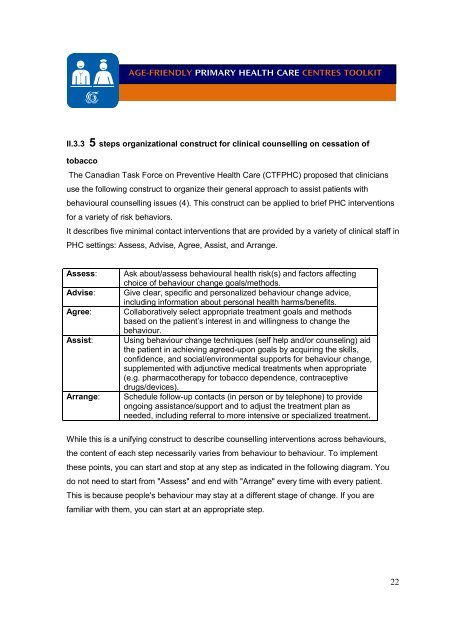Age-friendly Primary Health Care Centres Toolkit - World Health ...
Age-friendly Primary Health Care Centres Toolkit - World Health ...
Age-friendly Primary Health Care Centres Toolkit - World Health ...
- No tags were found...
Create successful ePaper yourself
Turn your PDF publications into a flip-book with our unique Google optimized e-Paper software.
AGE-FRIENDLY PRIMARY HEALTH CARE CENTRES TOOLKITII.3.3 5 steps organizational construct for clinical counselling on cessation oftobaccoThe Canadian Task Force on Preventive <strong>Health</strong> <strong>Care</strong> (CTFPHC) proposed that cliniciansuse the following construct to organize their general approach to assist patients withbehavioural counselling issues (4). This construct can be applied to brief PHC interventionsfor a variety of risk behaviors.It describes five minimal contact interventions that are provided by a variety of clinical staff inPHC settings: Assess, Advise, Agree, Assist, and Arrange.Assess:Advise:Agree:Assist:Arrange:Ask about/assess behavioural health risk(s) and factors affectingchoice of behaviour change goals/methods.Give clear, specific and personalized behaviour change advice,including information about personal health harms/benefits.Collaboratively select appropriate treatment goals and methodsbased on the patient’s interest in and willingness to change thebehaviour.Using behaviour change techniques (self help and/or counseling) aidthe patient in achieving agreed-upon goals by acquiring the skills,confidence, and social/environmental supports for behaviour change,supplemented with adjunctive medical treatments when appropriate(e.g. pharmacotherapy for tobacco dependence, contraceptivedrugs/devices).Schedule follow-up contacts (in person or by telephone) to provideongoing assistance/support and to adjust the treatment plan asneeded, including referral to more intensive or specialized treatment.While this is a unifying construct to describe counselling interventions across behaviours,the content of each step necessarily varies from behaviour to behaviour. To implementthese points, you can start and stop at any step as indicated in the following diagram. Youdo not need to start from "Assess" and end with "Arrange" every time with every patient.This is because people's behaviour may stay at a different stage of change. If you arefamiliar with them, you can start at an appropriate step.22
















